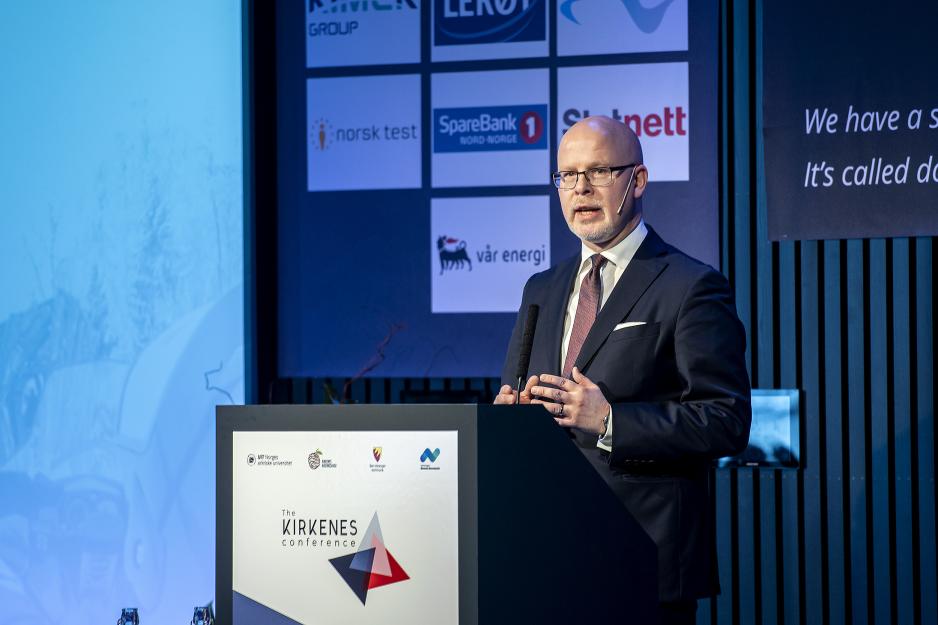At Ten Minutes’ Distance from a «Serious and Long-Lasting Threat Against Norway»

State Secretary Audun Halvorsen of the Norwegian Ministry of Foreign Affairs gave a thorough review of the situation in the High North at the first day of the Kirkenes conference. Photo: Jonas Karlsbakk, the Barents Secretariat
Kirkenes: The feeling of being in the middle of something that is spinning out of control is pressing on in the streets of Kirkenes. Exactly 14.8 kilometers away from the hotel at which I am staying, lies the country that is described as an efficient war machine with the will to have killing weaponry.
For a week and a half, the threat from Russia against the West is emphasized so strongly that the annual Kirkenes Conference’s continued insistence on good neighborly relations appears to be an LP record with a notch.
Kirkenes mayor Rune Rafaelsen, the local rock of Norwegian-Russian cooperation, greeted the conference in his usual way when reminding us that the most important thing is that “people from both sides of the border can meet”.
A series of warnings
Of course he is right. However, the reality is that the elephant has left the glass house. The glass house is a NATO riveted by internal fighting. Russia is the elephant that is no longer cooperating with the West.
The updated description of the good neighborly relationship between Norway and Russia started Monday last week. The Norwegian police security services told us that “the Russian security and intelligence services will represent the biggest challenges”. What Russia does, counterintelligence chief Hanne Blomberg expanded, is to “steal information and affect Norwegian decisions in a direction that serves Russia. They represent a serious and long-term threat against Norway”.
It only got worse when the Foreign Intelligence Services presented its analyses a week later. Lieutenant-General Morten Haga Lunde told us about new Russian weapons that make it possible for “Norway to end up behind Russian lines and with increased capacity this will be hard to prevent”.
As if we did not fully understand the gravity of the situation, Defense Minister Frank Bakke Jenssen followed up with a letter to Stortinget, the Norwegian parliament, in which he stated hat “the armed forces have a limited capacity to shoot down long-distance cruise missiles, and no capacity to shoot down ballistic missiles”.
Perhaps NATO Secretary-General Jens Stoltenberg thought some may have missed the gravity of the situation. Anyhow, he felt the need to literally paint an even bleaker image of the situation:
What do they want to tell us?
There is a good ten-minute drive from Kirkenes to the reality described by our most prominent experts. In the conference hall, before the attendees of the Kirkenes Conference, State Secretary Audun Halvorsen of the Norwegian MFA gave one of the most complete political reviews of the High North that I have ever heard.
Which if why he, of course, touched upon security policy challenges in his speech.
“We see Russia continuing to strengthen its military capacity through modernization and development of military capacity. This build-up is particularly strong on the Kola Peninsula, not far from where we stand. We see Russia conducting massive, complex military exercises on land and at sea, and that some of this activity takes place near our neighborhood.”
Sitting in the back row of a conference hall, I try to understand what the official Norway wants to tell us. Because while the gun smoke of security policy analyses still drifts over our heads, the discussion goes on about good neighborly relations, climate, business development, the importance of culture, demographic challenges, Arctic strategies and, in general, “business as usual”.
Requires two parties
It is even hard to focus on the severity of climate changes when the military industry is the strongest-growing industry.
For how are we, as local actors, to stay focused on something as marginal as the electrification of a ferry along the Nordland coastline when the arms industry literally torpedos any reasonable climate account balance?
Marginally, but as important - at least symbolically - is it when the first day of the Kirkenes Conference closes with an award ceremony in the name of Thorvald Stoltenberg. The Stoltenberg Award goes to someone who has promoted international dialogue and contact in the Barents Region. This year, the award went to Barents Press International, a gathering of free and independent journalists who work precisely with spreading knowledge and inviting dialogue across borders in the High North.
The award was well deserved, also because it encourages raising critical questions to both parties in the ongoing military escalation.
For it takes at least two parties to create both good an bad neighborly relations.

